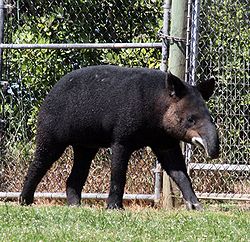| Tapirus veroensis Temporal range: | |
|---|---|
 | |
| Skeletal mount, American Museum of Natural History | |
| Scientific classification | |
| Kingdom: | Animalia |
| Phylum: | Chordata |
| Class: | Mammalia |
| Order: | Perissodactyla |
| Family: | Tapiridae |
| Genus: | Tapirus |
| Species: | †T. veroensis |
| Binomial name | |
| †Tapirus veroensis Sellards, 1918 | |
Tapirus veroensis is an extinct tapir species that lived in the area of the modern Eastern and Southern United States during the Pleistocene epoch (Irvingtonian-Rancholabrean). Tapirus veronensis is thought to have gone extinct around 11,000 years ago as part of the end-Pleistocene extinction event. [1]


